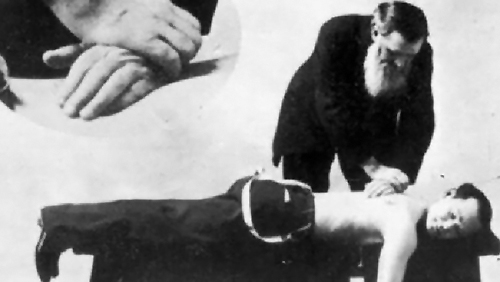Chiropractic & it’s History
From Wikipedia:
Chiropractic is a form of alternative medicine[1] concerned with the diagnosis, treatment and prevention of mechanical disorders of the musculoskeletal system, especially of the spine.[2] It is based on several pseudoscientific ideas.[3] |
Many chiropractors (often known informally as chiros), especially those in the field’s early history, have proposed that mechanical disorders of the joints, especially of the spine, affect general health,[2] and that regular manipulation of the spine (spinal adjustment) improves general health. The main chiropractic treatment technique involves manual therapy, especially manipulation of the spine, other joints, and soft tissues, but may also include exercises and health and lifestyle counseling.[4] A chiropractor may have a Doctor of Chiropractic (D.C.) degree and be referred to as “doctor” but is not a Doctor of Medicine (M.D.) or a Doctor of Osteopathic Medicine (D.O.).[5][6] While many chiropractors view themselves as primary care providers,[7][8] chiropractic clinical training does not meet the requirements for that designation.[2]
Systematic reviews of controlled clinical studies of treatments used by chiropractors have found no evidence that chiropractic manipulation is effective, with the possible exception of treatment for back pain.[7] A 2011 critical evaluation of 45 systematic reviews concluded that the data included in the study “fail[ed] to demonstrate convincingly that spinal manipulation is an effective intervention for any condition.”[9] Spinal manipulation may be cost-effective for sub-acute or chronic low back pain, but the results for acute low back pain were insufficient.[10] No compelling evidence exists to indicate that maintenance chiropractic care adequately prevents symptoms or diseases.[11]
There is not sufficient data to establish the safety of chiropractic manipulations.[12] It is frequently associated with mild to moderate adverse effects, with serious or fatal complications in rare cases.[13] There is controversy regarding the degree of risk of vertebral artery dissection, which can lead to stroke and death, from cervical manipulation.[14] Several deaths have been associated with this technique[13] and it has been suggested that the relationship is causative,[15][16] a claim which is disputed by many chiropractors.[16]
Chiropractic is well established in the United States, Canada, and Australia.[17] It overlaps with other manual-therapy professions such as osteopathy and physical therapy.[18] Most who seek chiropractic care do so for low back pain.[19] Back and neck pain are considered the specialties of chiropractic, but many chiropractors treat ailments other than musculoskeletal issues.[7] Chiropractic has two main groups: “straights”, now the minority, emphasize vitalism, “Innate Intelligence“, and consider vertebral subluxations to be the cause of all disease; and “mixers”, the majority, are more open to mainstream views and conventional medical techniques, such as exercise, massage, and ice therapy.[20]
D. D. Palmer founded chiropractic in the 1890s,[21] claiming that he had received it from “the other world”.[22] Palmer maintained that the tenets of chiropractic were passed along to him by a doctor who had died 50 years previously.[23] His son B. J. Palmer helped to expand chiropractic in the early 20th century.[21] Throughout its history, chiropractic has been controversial.[24][25] Its foundation is at odds with evidence-based medicine, and is underpinned by pseudoscientific ideas such as vertebral subluxation and Innate Intelligence.[26] Despite the overwhelming evidence that vaccination is an effective public health intervention, there are significant disagreements among chiropractors over the subject,[27] which has led to negative impacts on both public vaccination and mainstream acceptance of chiropractic.[28] The American Medical Association called chiropractic an “unscientific cult” in 1966[29] and boycotted it until losing an antitrust case in 1987.[8] Chiropractic has had a strong political base and sustained demand for services. In the last decades of the twentieth century, it gained more legitimacy and greater acceptance among conventional physicians and health plans in the United States.[8] During the COVID-19 pandemic, chiropractic professional associations advised chiropractors to adhere to CDC, WHO, and local health department guidance.[30][31] Despite these recommendations, a small but vocal and influential number of chiropractors spread vaccine misinformation.[32]
Source: https://en.wikipedia.org/wiki/Chiropractic
History
The history of chiropractic began in 1895 when Daniel David Palmer of Iowa performed the first chiropractic adjustment on a partially deaf janitor, Harvey Lillard. While Lillard was working without his shirt on in Palmer’s office, Lillard bent over to empty the trash can. Palmer noticed that Lillard had a vertebra out of position. He asked Lillard what happened, and Lillard replied, “I moved the wrong way, and I heard a ‘pop’ in my back, and that’s when I lost my hearing.” Palmer, who was also involved in many other natural healing philosophies, had Lillard lie face down on the floor and proceeded with the adjustment. The next day, Lillard told Palmer, “I can hear that rackets on the streets.”[1][page needed] This experience led Palmer to open a school of chiropractic two years later. Rev. Samuel H. Weed coined the word “chiropractic” by combining the Greek words cheiro (hand) and praktikos (doing or action).
Chiropractic’s early philosophy was rooted in vitalism, naturalism, magnetism, spiritualism and other constructs that are not amenable to the scientific method, although Palmer tried to merge science and metaphysics.[2] In 1896, Palmer’s first descriptions and underlying philosophy of chiropractic echoed Andrew Still‘s principles of osteopathy established a decade earlier.[3] Both described the body as a “machine” whose parts could be manipulated to produce a drugless cure. Both professed the use of spinal manipulation on joint dysfunction/subluxation to improve health. Palmer distinguished his work by noting that he was the first to use short-lever HVLA (high velocity low amplitude) joint manipulation techniques using the spinous process and transverse processes as mechanical levers. He described the effects of chiropractic spinal manipulation as being mediated primarily by the nervous system.[4]
Despite the similarities between chiropractic and osteopathy, the latter’s practitioners sought to differentiate themselves by seeking licensure to regulate the profession, calling chiropractic a “bastardized form of osteopathy”.[3] In 1907 in a test of the new osteopathy law, a Wisconsin-based chiropractor was charged with practicing osteopathic medicine without a license. Practicing medicine without a license led to many chiropractors, including D.D. Palmer, being jailed.[3] Ironically, Palmer’s legal defence of chiropractic consisted of the first chiropractic textbook Modernized Chiropractic published in 1906, written by “mixer” chiropractors Longworthy, Smith, et al., whom Palmer despised. Although the chiropractors won their first test case in Wisconsin in 1907, prosecutions instigated by state medical boards became increasingly common and in many cases they were successful. In response, chiropractors conducted political campaigns to secure separate licensing statutes, eventually succeeding in all fifty states, from Kansas in 1913 to Louisiana in 1974.
Division within the profession has been intense, with “mixers” combining spinal adjustments with other treatments, and “straights” relying solely on spinal adjustments. A conference sponsored by the National Institutes of Health in 1975 spurred the development of chiropractic research. The American Medical Association called chiropractic an “unscientific cult”[5] and boycotted it until losing a 1987 antitrust case.[6]: 34 For most of its existence, chiropractic has battled with mainstream medicine, sustained by antiscientific and pseudoscientific ideas such as vertebral subluxation.[6]: p37 By the mid-1990s there was a growing scholarly interest in chiropractic.[6]
Manual therapy predating Chiropractic
The practice of joint manipulation dates back to ancient times and has roots in most countries. The earliest known medical text, the Edwin Smith papyrus of 1552 BC, describes the Ancient Egyptian treatment of bone-related injuries. These early bone-setters would treat fractures with wooden splints wrapped in bandages or made a cast around the injury out of a plaster-like mixture. It is not known whether they performed amputations as well.[7] With the advancement of modern medicine beginning in the 18th century, bone-setters began to be recognised for their efficiency in treatment but did not receive the praise or status that physicians did. Some of these self-taught healers were considered legitimate, while others were perceived as “quacks“. In Great Britain, one of the most famous was the bone-setter Sally Mapp (d. 1737).[8] Known as “Crazy Sally”, she learned her skill from her father and was known for her arm strength[9] and ability to reset almost any bone. Though she lacked the medical education of physicians, she successfully treated dislocated shoulders and knees, among other treatments, at the Grecian Coffee House in London and in the town of Epsom.[8][9] Bone-setters treated the majority of the population since they were cheaper than licensed physicians. Royal families would employ bone-setters when the court physicians were inadequate or inefficient.[10]
Source: https://en.wikipedia.org/wiki/History_of_chiropractic
References from: https://en.wikipedia.org/wiki/Main_Page



